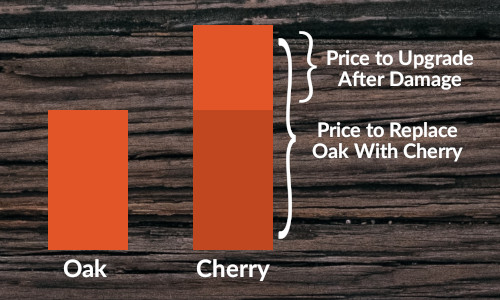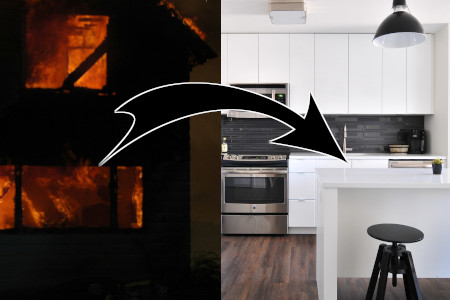In the unfortunate event that your home suffers damage from an accident, it’s reassuring to know that you have an insurance policy that will pay the cost of restoration. However, many homeowners wonder, “can I upgrade during restoration?” Maybe you’d like to get a new roof, instead of just a patch job. Perhaps you had a kitchen fire, and a whole new kitchen is in order. Is this feasible?
Absolutely!
However, there are some pitfalls to watch out for when taking on an upgrade during restoration, and we’re here to show you how it’s done!
Table of Contents
Step 1: Secure Bids for BOTH Restoration AND Remodeling
The first step to upgrading during restoration is to get a bids for BOTH the restoration of your property, AND the upgrades you’re thinking of completing. First, ask your contractors for bids to restore the property to its original condition. (Also, be sure that the contractors that are providing bids for you are reputable, licensed, bonded, and insured!) Then ask them for another set of bids for the upgrades you’d like to complete, so you’ll know what costs you’ll need to pay yourself. Remember that there may be items on your bids that will need to be completed whether you decide to upgrade or not, so be sure to keep track of these.
Once you have collected bids to restore the property to its original condition, you’ll need to send these on to your insurance company. They’ll assess the bids against industry standard rates for your area, and decide how much they’ll pay for the necessary restorations.
Once your insurance company provides the exact amount that they’ll pay for the restoration project, you’ll have the information you need to help you determine what you can do. Begin by comparing how much the insurance company will pay against how much you have in your budget for upgrades and what upgrades you want done.
Be sure to contact the insurance company to notify them of your prosed upgrades. Transparency with the insurance company is vital in this process.
Step 2: Balance Your Budget and Desires
If you had a fire in your kitchen and wanted to upgrade during restoration, take a look around. What changes would you make? If the old kitchen had oak cabinets and laminate countertops, you might like to replace them with new Cherry cabinets and granite countertops. Depending upon your tastes and budget, there are lots of things you can do!
Let’s use some simple round numbers to explore options. Let’s say that the insurance company will pay for the oak cabinets and countertops to be replaced at a cost of $10,000. The contractor you’ve chosen can put in new Cherry wood cabinets with nice granite countertops at a cost of $15,000. Since the insurance company will pay $10,000 to replace the cabinets and countertops, you’d be able to get new, Charry cabinets and granite countertops for only $5,000. Fantastic deal!
The key here is to balance your budget with desires. There are lots of beautiful and stylish kitchen materials that can be used in your remodel project that will meet your budget. Don’t be afraid to share your budget and goals with your contractor. They will provide you with lots of options that can provide you with a nice kitchen that’s within your budget.

Caveats:
Downgrading
Downgrading is generally considered acceptable under most policies, but exercise caution! You CAN do the work yourself, or hire a friend to do it for you. In fact, you could use the money from the insurance company to go to Disneyland. However, if you don’t complete the repairs (or they’re not done professionally), and something happens AGAIN to that same area, insurance will probably not cover it!
When Upgrading is the Only Option
If an equivalent replacement is not an option, either because it is no longer sold, or is no longer compatible, then the insurance will have to pay for somewhat of an upgrade. Insurance will pay for the closest replacement possible, or if that’s not available, something slightly better.
Update the Insurance Company
Transparency with the insurance company is vital. You definitely want to notify them if you decide to do an upgrade during restoration. This is important because, if you perform upgrades, but don’t tell your insurance company, and something happens to the upgraded area(s), insurance is only going to cover what was there BEFORE you upgraded. Not good! So, be sure to keep your insurance agent up to date on your plans. Is it likely that your insurance policy will be more expensive in the event that you perform significant upgrades? Indeed! But it shouldn’t be too much.
House Additions
Home additions can also be combined with restoration. The addition will have to come out of your wallet, but doing both can still save money for several reasons.
First, the damaged structure provides a clean slate, simplifying the addition process. Contractors can seamlessly integrate new rooms, optimizing space and functionality. This streamlined approach ensures a more straightforward construction process, minimizing disruptions. Leverage the rebuilding phase to effortlessly expand your living space, creating a home that not only recovers from damages but flourishes with improved design and utility.
Second, leveraging shared resources can maximize efficiency. By combining these projects, you capitalize on economies of scale, sharing labor, materials, and equipment. This collaborative approach ensures a more cost-effective transformation, as both restoration and addition benefit from streamlined processes.
Third, choosing to remodel and renovate simultaneously is a strategic move that minimizes disruptions to your daily life. With both projects underway together, contractors can coordinate efforts, reducing overall construction time. This approach ensures a more efficient process, sparing you from prolonged inconvenience. normally you’d have to find another living space when your house is being restored, then have to do it again when renovation starts, or deal with the inconvenience of having a construction crew hammering away in your home. When doing both at the same time, you can cut down on these disruptions.

By seamlessly integrating repairs, additions, and renovations, homeowners not only address damages but elevate their living spaces to new heights. From cost savings and shared resources to minimized disruptions, this comprehensive guide emphasizes the importance of a holistic approach. Embrace the opportunity to rebuild not just structures but resilience, creating a home that not only withstands challenges but emerges stronger and more vibrant.
If you need help with remodeling after damage to your home, then you can contact us using the form below. We specialize in many forms of restoration and are licensed for general contracting!


